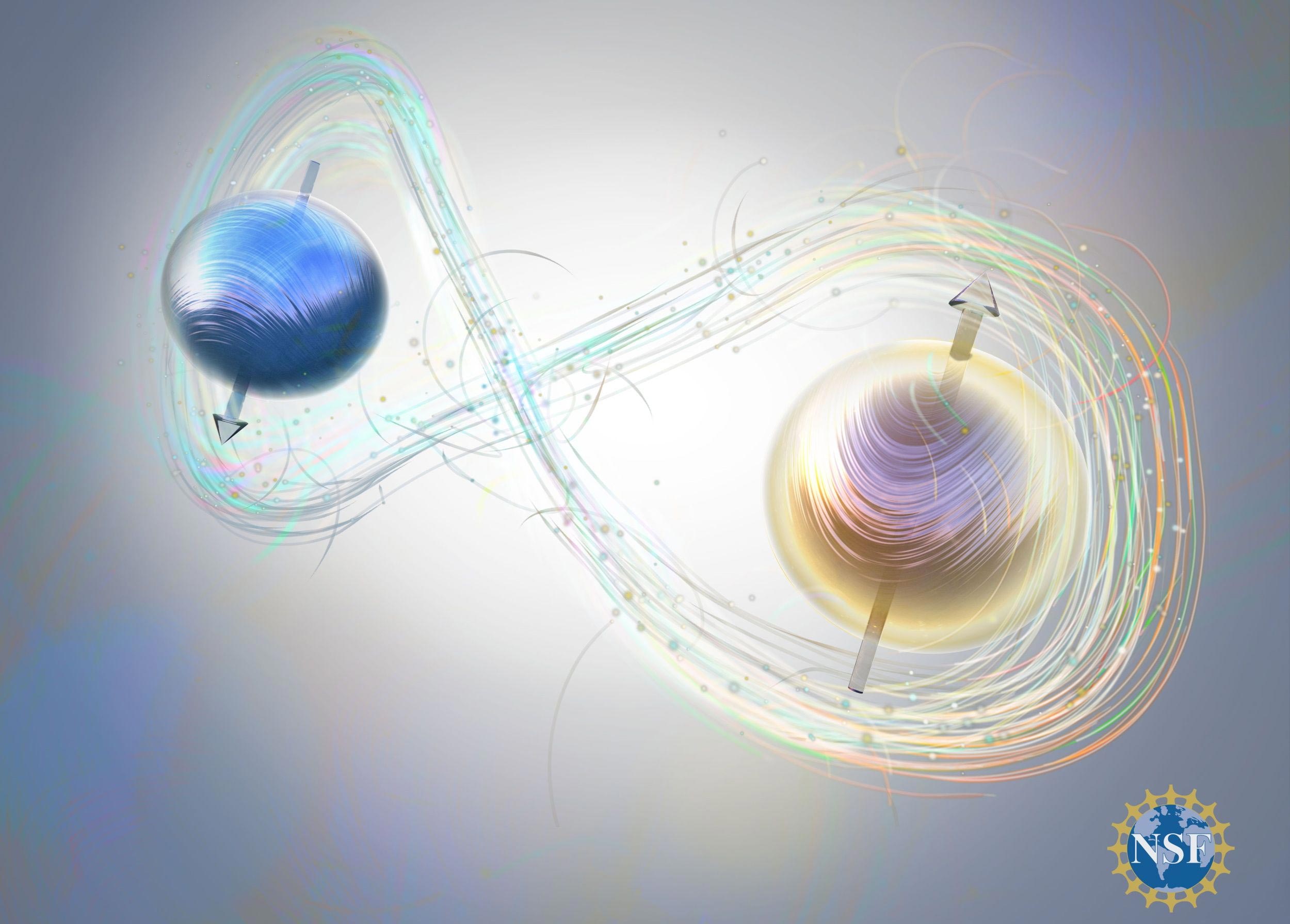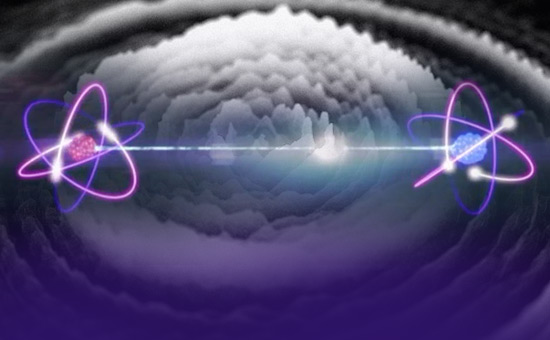Quantum Entanglement: Exploring the Resonant Fabric of Existence

Introduction
Quantum entanglement is a profound phenomenon in quantum mechanics where two or more particles become inextricably linked, regardless of the distance between them. This correlation defies classical intuition and has led to debates about the nature of reality, space, and time.
The EPR Paradox
In 1935, Albert Einstein, Boris Podolsky, and Nathan Rosen proposed a thought experiment called the EPR paradox. They imagined two entangled particles, each with a random spin state (up or down). They argued that by measuring the spin of one particle, the spin of the other particle would instantly become known, even if they were light-years apart. This seemed to violate the principle of locality, which states that physical interactions cannot travel faster than the speed of light.
Bell’s Theorem
In the 1960s, John Bell proposed a mathematical theorem that tested the predictions of the EPR paradox. Bell’s theorem demonstrated that if quantum mechanics is correct, then certain correlations between entangled particles cannot be explained by any local hidden variable theory.
Experimental Verification
Numerous experiments have since verified Bell’s theorem, providing strong evidence for the existence of quantum entanglement. These experiments have been performed over distances of thousands of kilometers, confirming that the correlations between entangled particles are instantaneous.
Implications for Reality
Quantum entanglement suggests that reality is not as local or deterministic as we once thought. It implies that particles can influence each other at vast distances, challenging our understanding of space and causality. Some interpretations of quantum mechanics even suggest that the universe may be non-local, meaning that events in different parts of the universe may be inherently interconnected.
Applications
Quantum entanglement has promising applications in various fields, including:
- Quantum Computing: Entangled qubits (quantum bits) can perform certain computations exponentially faster than classical computers.
- Quantum Cryptography: Entangled particles can be used to securely transmit information in a way that is impervious to eavesdropping.
- Quantum Teleportation: Entangled particles can be used to transfer quantum information from one location to another without physically transferring the particles themselves.
Conclusion
Quantum entanglement is a remarkable phenomenon that has profound implications for our understanding of reality. It challenges classical notions of locality, causality, and determinism, and opens up new possibilities for technological advancements. As we continue to explore the resonant fabric of existence, quantum entanglement will undoubtedly play a pivotal role in shaping our understanding of the universe and our place within it.## Quantum Entanglement: Exploring The Resonant Fabric Of Existence
Executive Summary

Quantum entanglement, a bewildering phenomenon at the heart of quantum mechanics, has captivated scientists and philosophers alike. This article delves into the multifaceted nature of quantum entanglement, unraveling its far-reaching implications for our understanding of the universe. From its theoretical foundations to its practical applications, we explore the profound impact of quantum entanglement on our perceptions of reality and the boundless possibilities it holds for the future.

Introduction
Quantum entanglement, a peculiar quantum mechanical phenomenon, transcends the conventional confines of classical physics. It involves the creation of a profound link between two or more particles, such that their properties become inextricably intertwined, regardless of the distance that separates them. This mysterious connection allows the particles to share a common fate, instantly influencing one another across vast cosmic distances.
FAQs
Q: What is Quantum Entanglement?
A: Quantum entanglement refers to the phenomenon in which two or more particles become interlinked, sharing a unified quantum state. This interconnectedness extends beyond physical proximity, implying a profound correlation between their properties and behaviors.
Q: Can Quantum Entanglement Be Broken?
A: Surprisingly, quantum entanglement cannot be completely severed. While it is possible to disrupt the link between entangled particles by introducing external influences, the connection itself remains unbroken, despite the distance separating the particles.
Q: What Are the Potential Applications of Quantum Entanglement?
A: Quantum entanglement holds immense promise for advancing various fields, including quantum computing, cryptography, and medical diagnostics. By harnessing the power of entanglement, scientists envision the development of groundbreaking technologies that could revolutionize our technological capabilities.
Subtopics
1. The EPR Paradox and the Foundations of Quantum Entanglement
- Einstein-Podolsky-Rosen (EPR) paradox: A thought experiment challenging the completeness of quantum mechanics.
- Bell’s theorem: A mathematical proof demonstrating the non-classical correlations inherent in quantum entanglement.
- Schrödinger’s cat: A paradoxical thought experiment highlighting the implications of quantum superposition and entanglement.
2. The Many-Worlds Interpretation and Quantum Entanglement
- Many-worlds interpretation: A theory positing the coexistence of multiple, parallel universes, each representing a different outcome of every quantum event.
- Decoherence: The process by which the quantum state of a system loses its coherence, potentially resolving the Schrödinger’s cat paradox.
- Quantum superposition: The enigmatic state in which particles exist in multiple states simultaneously, exemplified by Schrödinger’s cat.
3. Quantum Cryptography and Entangled Particles
- Quantum cryptography: A method of secure communication that harnesses entanglement for unbreakable encryption.
- Quantum key distribution (QKD): A technique for distributing cryptographic keys using entangled particles, ensuring information secrecy.
- Unconditional security: The inherent resistance of quantum cryptography to eavesdropping, providing unparalleled security.
4. Quantum Computing and Entangled Qubits
- Quantum computing: A groundbreaking computational paradigm leveraging entangled quantum bits (qubits) for exponentially enhanced processing capabilities.
- Quantum algorithms: Specialized algorithms designed for quantum computers, promising transformative solutions in optimization, machine learning, and molecular simulations.
- Quantum supremacy: The point at which quantum computers outperform classical computers in specific computational tasks.
5. Medical Applications of Quantum Entanglement
- Quantum imaging: Techniques using entangled particles to enhance medical imaging modalities, improving diagnostic capabilities.
- Quantum biosensors: Ultra-sensitive devices utilizing entanglement for advanced biological sensing, enabling early disease detection.
- Targeted drug delivery: Exploiting entanglement for precise drug delivery to specific cells, maximizing therapeutic efficacy.
Conclusion
Quantum entanglement, with its inherent non-locality and profound correlations, challenges our classical intuitions and invites us to contemplate a deeper, interconnected reality. It holds the potential to revolutionize diverse fields, driving scientific progress and shaping the trajectory of future technologies. As we continue to unravel the mysteries of quantum entanglement, we step closer to unlocking its full potential, potentially transforming our understanding of the universe and our place within it.
Keyword Tags
- Quantum Entanglement
- Bell’s Theorem
- Schrödinger’s Cat
- Quantum Cryptography
- Quantum Computing


